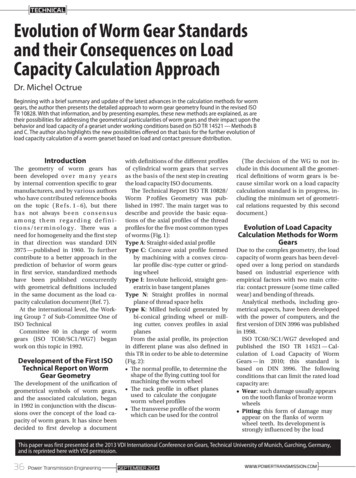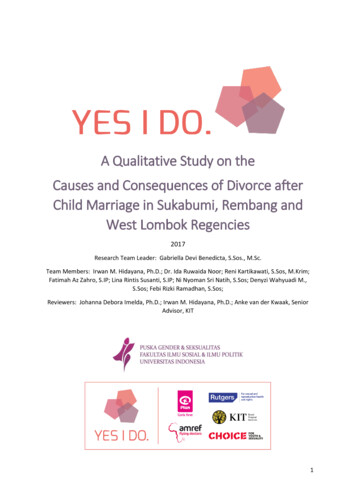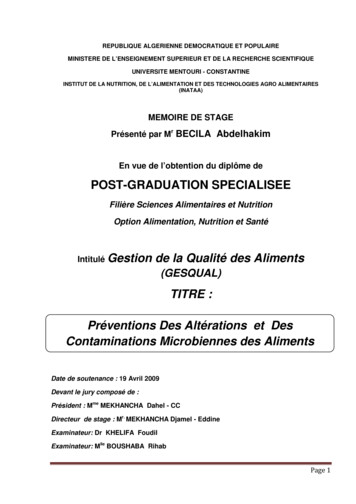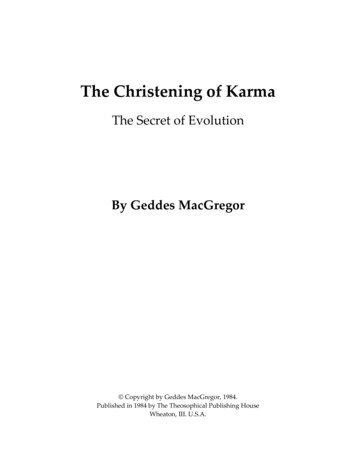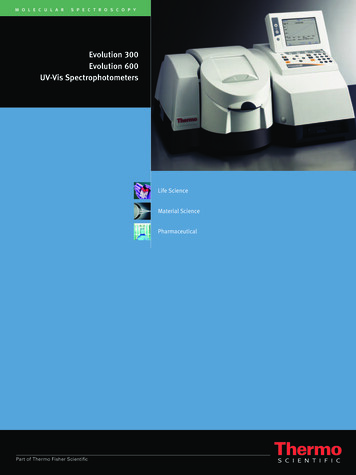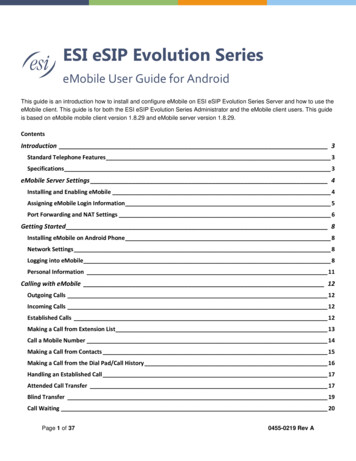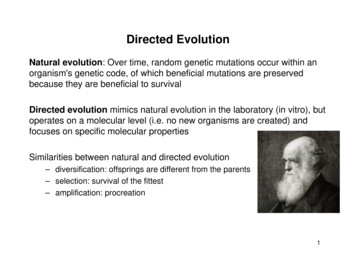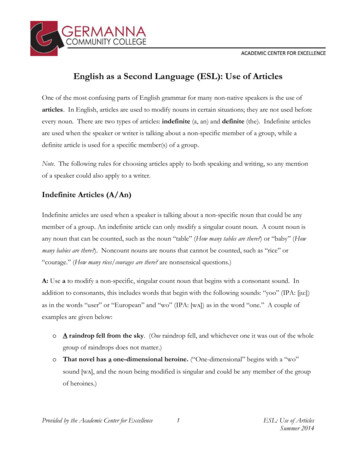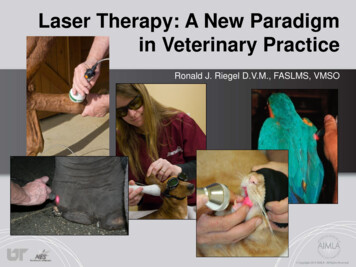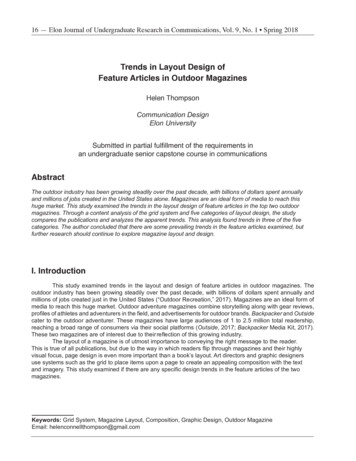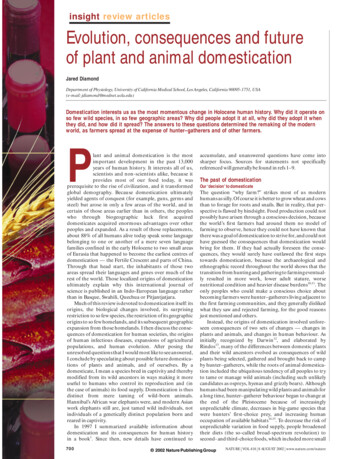
Transcription
insight review articlesEvolution, consequences and futureof plant and animal domesticationJared DiamondDepartment of Physiology, University of California Medical School, Los Angeles, California 90095-1751, USA(e-mail: jdiamond@mednet.ucla.edu)Domestication interests us as the most momentous change in Holocene human history. Why did it operate onso few wild species, in so few geographic areas? Why did people adopt it at all, why did they adopt it whenthey did, and how did it spread? The answers to these questions determined the remaking of the modernworld, as farmers spread at the expense of hunter–gatherers and of other farmers.Plant and animal domestication is the mostimportant development in the past 13,000years of human history. It interests all of us,scientists and non-scientists alike, because itprovides most of our food today, it wasprerequisite to the rise of civilization, and it transformedglobal demography. Because domestication ultimatelyyielded agents of conquest (for example, guns, germs andsteel) but arose in only a few areas of the world, and incertain of those areas earlier than in others, the peopleswho through biogeographic luck first acquireddomesticates acquired enormous advantages over otherpeoples and expanded. As a result of those replacements,about 88% of all humans alive today speak some languagebelonging to one or another of a mere seven languagefamilies confined in the early Holocene to two small areasof Eurasia that happened to become the earliest centres ofdomestication — the Fertile Crescent and parts of China.Through that head start, the inhabitants of those twoareas spread their languages and genes over much of therest of the world. Those localized origins of domesticationultimately explain why this international journal ofscience is published in an Indo-European language ratherthan in Basque, Swahili, Quechua or Pitjantjatjara.Much of this review is devoted to domestication itself: itsorigins, the biological changes involved, its surprisingrestriction to so few species, the restriction of its geographicorigins to so few homelands, and its subsequent geographicexpansion from those homelands. I then discuss the consequences of domestication for human societies, the originsof human infectious diseases, expansions of agriculturalpopulations, and human evolution. After posing theunresolved questions that I would most like to see answered,I conclude by speculating about possible future domestications of plants and animals, and of ourselves. By adomesticate, I mean a species bred in captivity and therebymodified from its wild ancestors in ways making it moreuseful to humans who control its reproduction and (inthe case of animals) its food supply. Domestication is thusdistinct from mere taming of wild-born animals.Hannibal’s African war elephants were, and modern Asianwork elephants still are, just tamed wild individuals, notindividuals of a genetically distinct population born andreared in captivity.In 1997 I summarized available information aboutdomestication and its consequences for human historyin a book1. Since then, new details have continued to700accumulate, and unanswered questions have come intosharper focus. Sources for statements not specificallyreferenced will generally be found in refs 1–9.The past of domesticationOur ‘decision’ to domesticateThe question “why farm?” strikes most of us modernhumans as silly. Of course it is better to grow wheat and cowsthan to forage for roots and snails. But in reality, that perspective is flawed by hindsight. Food production could notpossibly have arisen through a conscious decision, becausethe world’s first farmers had around them no model offarming to observe, hence they could not have known thatthere was a goal of domestication to strive for, and could nothave guessed the consequences that domestication wouldbring for them. If they had actually foreseen the consequences, they would surely have outlawed the first stepstowards domestication, because the archaeological andethnographic record throughout the world shows that thetransition from hunting and gathering to farming eventually resulted in more work, lower adult stature, worsenutritional condition and heavier disease burdens10,11. Theonly peoples who could make a conscious choice aboutbecoming farmers were hunter–gatherers living adjacent tothe first farming communities, and they generally dislikedwhat they saw and rejected farming, for the good reasonsjust mentioned and others.Instead, the origins of domestication involved unforeseen consequences of two sets of changes — changes inplants and animals, and changes in human behaviour. Asinitially recognized by Darwin12, and elaborated byRindos13, many of the differences between domestic plantsand their wild ancestors evolved as consequences of wildplants being selected, gathered and brought back to campby hunter–gatherers, while the roots of animal domestication included the ubiquitous tendency of all peoples to tryto tame or manage wild animals (including such unlikelycandidates as ospreys, hyenas and grizzly bears). Althoughhumans had been manipulating wild plants and animals fora long time, hunter–gatherer behaviour began to change atthe end of the Pleistocene because of increasinglyunpredictable climate, decreases in big-game species thatwere hunters’ first-choice prey, and increasing humanoccupation of available habitats14,15. To decrease the risk ofunpredictable variation in food supply, people broadenedtheir diets (the so-called broad-spectrum revolution) tosecond- and third-choice foods, which included more small 2002 Nature Publishing GroupNATURE VOL 418 8 AUGUST 2002 www.nature.com/nature
insight review articlesHorseZebraSheepNorth Americanbighorn sheepGoatRocky Mountain goatElkReindeerCowAfrican buffaloAlmondOakFigure 1 Comparisons of domesticated wild species (left of each pair) and their never-domesticated close relatives (right) reveal the subtle factors that can derail domestication.game, plus plant foods requiring much preparation, such as grinding, leaching and soaking14,16. Eventually, people transported somewild plants (such as wild cereals) from their natural habitats to moreproductive habitats and began intentional cultivation17.The emerging agricultural lifestyle had to compete with the established hunter–gatherer lifestyle. Once domestication began to arise,the changes of plants and animals that followed automatically underdomestication, and the competitive advantages that domesticationconveyed upon the first farmers (despite their small stature and poorhealth), made the transition from the hunter–gatherer lifestyle tofood production autocatalytic — but the speed of that transitionvaried considerably among regions18,19. Thus, the real question aboutthe origins of agriculture, which I consider below, is: why did foodproduction eventually outcompete the hunter–gatherer lifestyle overalmost the whole world, at the particular times and places that it did,but not at earlier times and other places?Changes of wild species under domesticationThese changes are particularly well understood for southwest Asia’sFertile Crescent, the site of domestication that was earliest in theworld and that yielded what are still the world’s most valuabledomestic plant and animal species. For most species domesticatedthere, the wild ancestor and its wild geographic range have beenidentified, its relation to the domesticate proven by genetic andchromosomal studies, its changes under domestication delineated(often at the gene level), those changes traced in successive layers ofNATURE VOL 418 8 AUGUST 2002 www.nature.com/naturethe archaeological record, and the approximate time and place ofits domestication identified9.For example, wild wheats and barley bear their seeds on top of astalk that spontaneously shatters, dropping the seeds to the groundwhere they can germinate (but where they also become difficult forhumans to gather). An occasional single-gene mutation that preventsshattering is lethal in the wild (because the seeds fail to drop), butconveniently concentrates the seeds for human gatherers. Oncepeople started harvesting those wild cereal seeds, bringing them backto camp, accidentally spilling some, and eventually planting others,seeds with a non-shattering mutation became unconsciouslyselected for rather than against9,17.Individual wild animals also vary in traits affecting their desirability to humans. Chickens were selected to be larger, wild cattle(aurochs) to be smaller, and sheep to lose their bristly outer hairs (thekemp) and not to shed their soft inner hairs (the wool). Mostdomestic animals, including even recently domesticated trout20,have smaller brains and less acute sense organs than do their wildancestors. Good brains and keen eyes are essential to survival in thewild, but represent a quantitatively important waste of energy in thebarnyard, as far as humans are concerned3,21.Especially instructive are cases in which the same ancestral speciesbecame selected under domestication for alternative purposes,resulting in very different-appearing breeds or crops. For instance,dogs were variously selected to kill wolves, dig out rats, race, be eaten,or be cuddled in our laps. What naive zoologist glancing at 2002 Nature Publishing Group701
insight review articleswolfhounds, terriers, greyhounds, Mexican hairless dogs andchihuahuas would even guess them to belong to the same species?Similarly, cabbage (Brassica oleracea) was variously selected for itsleaves (cabbage and kale), stems (kohlrabi), flower shoots (broccoliand cauliflower) and buds (brussels sprouts).Why so few wild species were domesticatedThe wild animal species that most plausibly could have yieldedvaluable domesticates were large terrestrial mammalian herbivoresand omnivores, of which the world holds 148 species weighing 45 kgor more (Table 9.2 of ref. 1). Yet only 14 of those 148 species wereactually domesticated (Table 9.1 of ref. 1), prompting us to ask whatprevented domestication of the other 134 species? Similarly, worldwide there are about 200,000 wild species of higher plants, of whichonly about 100 yielded valuable domesticates. Especially surprisingare the many cases in which only one of a closely related group ofspecies became domesticated. For example, horses and donkeys weredomesticated, but none of the four zebra species congeneric and ableto interbreed with them3,22.The key question concerning this selectivity of domestication is asfollows: in the cases of all those species never domesticated, did thedifficulty lie with the species itself, or with the people indigenous tothe area to which the species was native? For instance, is theabundance of large wild mammals the reason why no mammalspecies was ever domesticated in subequatorial Africa, makingdomestication superfluous for Africans? If that explanation werecorrect, then African people should also have ignored Eurasiandomestic mammals when those were finally introduced to Africa,and European animal breeders on arriving in Africa should havesucceeded in domesticating some African wild mammals, but both ofthose predictions are refuted by the actual course of history.Six independent lines of evidence1 converge to prove that, in mostcases, the obstacle lay with the species itself, not with the local people:the rapid acceptance of introduced Eurasian domesticates bynon-Eurasian peoples; the rapid ancient domestication of the mostvaluable wild species; the repeated independent domestications ofmany of them; the failure of even modern European plant andanimal breeders to add significantly to our short list of valuabledomesticates; ancient discoveries of the value of thousands of speciesthat were regularly harvested in the wild but that never becamedomesticated; and the identification of the particular reasonspreventing the domestication of many of those species.Comparisons of domesticated wild species with never-domesticated close relatives illustrate the subtle factors that can deraildomestication1 (Fig. 1). For example, it is initially surprising that oaktrees, the most important wild food plant in many parts of Eurasia andNorth America, were never domesticated. Like wild almonds, acornsof most individual wild oaks contain bitter poisons, with occasionalnon-poisonous mutant trees preferred by human foragers. However,the non-poisonous condition is controlled by a single dominant genein almonds but polygenically in oaks, so that offspring of the occasional non-poisonous individuals are often non-poisonous in almondsbut rarely so in oaks, preventing selection of edible oak varieties to thisday. A second example is provided by the European horse breederswho settled in South Africa in the 1600s and — like African herders forprevious millennia — tried to domesticate zebras. They gave up afterseveral centuries for two reasons. First, zebras are incurably vicious,have the bad habit of biting a handler and not letting go until thehandler is dead, and thereby injure more zoo-keepers each year thando tigers. Second, zebras have better peripheral vision than horses,making them impossible even for professional rodeo cowboys to lasso(they see the rope coming and flick away their head).Among wild mammal species that were never domesticated, thesix main obstacles proved to be a diet not easily supplied by humans(hence no domestic anteaters), slow growth rate and long birth spacing (for example, elephants and gorillas), nasty disposition (grizzlybears and rhinoceroses), reluctance to breed in captivity (pandas and702cheetahs), lack of follow-the-leader dominance hierarchies (bighornsheep and antelope), and tendency to panic in enclosures or whenfaced with predators (gazelles and deer, except reindeer). Manyspecies passed five of these six tests but were still not domesticated,because they failed a sixth test. Conclusions about non-domesticability from the fact of non-domestication are not circular, because thesesix obstacles can be assessed independently.Why there were so few homelands of agricultureFood production bestowed on farmers enormous demographic,technological, political and military advantages over neighbouringhunter–gatherers. The history of the past 13,000 years consists of talesof hunter–gatherer societies becoming driven out, infected,conquered or exterminated by farming societies in every area of theworld suitable for farming. One might therefore have naivelyanticipated that, in any part of the world, one or more of thelocal hunter–gatherer societies would have stumbled upon domestication, become farmers, and thereby outcompeted the otherlocal hunter–gatherer societies. In fact, food production aroseindependently in at most nine areas of the world (Fertile Crescent,China, Mesoamerica, Andes/Amazonia, eastern United States, Sahel,tropical West Africa, Ethiopia and New Guinea).The puzzle increases when one scrutinizes that list of homelands.One might again naively have expected the areas most productive forfarming today to correspond, at least roughly, to the areas most productive in the past. In reality, the list of homelands and the list ofbreadbaskets of the modern world are almost mutually exclusive(Fig. 2). The latter list includes California, North America’s GreatPlains, Europe, the pampas of Argentina, the cape of southern Africa,the Indian subcontinent, Java and Australia’s wheat belt. Becausethese areas are evidently so well suited to farming or herding today,why were they not so in the past?The explanation is that the homelands of agriculture were insteadmerely those regions to which the most numerous and most valuabledomesticable wild plant and animal species were native. Only inthose areas were incipient early farmers able to outcompete localhunter–gatherers. Once those locally available wild species had beendomesticated and had spread outside the homelands, societies ofhomelands had no further advantage other than that of a head start,and they were eventually overtaken by societies of more fertile orclimatically more favoured areas outside the homelands.For instance, the Fertile Crescent of southwest Asia was home towild wheats, barley, peas, sheep, goats, cows and pigs — a list thatincludes what are still the most valuable crops and livestock of themodern world. Hence hunter–gatherers of the Fertile Crescentdomesticated those species and became the world’s first farmers andherders, beginning around 8500 BC1,9,23. That head start in foodproduction led to them and their close neighbours also developingthe world’s first metal tools, writing, empires and professionalarmies. Those tools of conquest, and Fertile Crescent human genes,gradually spread west into Europe and North Africa and east into thewestern Indian subcontinent and central Asia. However, once thosecrops, livestock and human inventions had spread, Fertile Crescentsocieties possessed no other advantages. As all of those elementsslowly spread northwest across Europe, farming and power alsoshifted northwest from the Fertile Crescent to areas where farminghad never arisen independently — first to Greece, then to Italy, andfinally to northwest Europe. Human societies of the Fertile Crescentinadvertently committed slow ecological suicide in a zone of lowrainfall prone to deforestation, soil erosion and salinization.The spread of food productionFrom the homelands of domestication, food production spreadaround the world in either of two ways. The much less common waywas for hunter–gatherers outside the homelands to acquire crops orlivestock from the homelands, enabling them to settle down as farmers or herders, as attested by archaeological evidence for substantial 2002 Nature Publishing GroupNATURE VOL 418 8 AUGUST 2002 www.nature.com/nature
insight review articlesFigure 2 Ancient and modern centres ofagriculture. Ancient centres of origin of plant andanimal domestication — the nine homelands offood production — are indicated by the orangeshaded areas on the map (based on Fig. 5.1 ofEastern USref. 1). The most agriculturally productive areasof the modern world, as judged by cereals andmajor staples, are indicated by the yellow-shadedareas. Note that there is almost no overlapbetween the areas highlighted, except that Chinaappears on both distributions, and that the most Mesoamericaproductive areas of the central United Statestoday approach areas of the eastern UnitedStates where domestication originated. TheAndes andAmazoniareason why the two distributions are so differentis that agriculture arose in areas to which the wildancestors of the most valuable domesticablecrops and animals were native, but other areasproved much more productive when thosevaluable domesticates reached them.continuity of material culture, and by genetic, linguistic and skeletalevidence of continuity of human populations. The clearest suchexample of local adoption of food production is in southern Africa,where around 2,000 years ago some Khoisan hunter–gatherersacquired Eurasian livestock (cattle, sheep and goats) arriving fromthe north and became herders (so-called Hottentots). Much moreoften, however, local hunter–gatherers had no opportunity toacquire crops and livestock before they were overrun or replaced byfarmers expanding out of the homelands, exploiting their demographic, technological, political and military advantages over thehunter–gatherers.Expansions of crops, livestock, and even people and technologiestended to occur more rapidly along east–west axes than alongnorth–south axes1 (Fig. 3). The reason is obvious: locations at thesame latitude share identical day-lengths and seasonalities, oftenshare similar climates, habitats and diseases, and hence require lessevolutionary change or adaptation of domesticates, technologies andcultures than do locations at different latitudes. Examples include therapid westwards and eastwards dispersal of wheat, horses, wheels andwriting of western Asian origin, and the westwards dispersal ofchickens, citrus and peaches of Chinese origin, along the east–westaxis of Eurasia. This can be contrasted with the slow spread ofEurasian livestock and non-spread of Eurasian crops southwardsalong Africa’s north–south axis24, the slow spread of Mexican cornand the non-spread of Mexican writing and wheels and Andeanllamas and potatoes along the Americas’ north–south axis, and theslow spread of food production southwards along the north–southaxis of the Indian subcontinent.This is not to deny the existence of ecological barriers at the samelatitude within Asia and North America, but the general patternremains. Eurasia’s east–west axis, and the resulting rapid enrichmentof societies in each part of Eurasia by crops and technologies fromother parts of Eurasia, became one of the main ultimate reasons whyEurasian peoples conquered Native American peoples, rather thanvisa versa. Eurasia’s east–west axis also explains why there is much lessevidence for multiple independent domestications of the same plantspecies (see below), and much more evidence for agriculturallydriven language expansions, in Eurasia than in the Americas.Consequences of domesticationConsequences for human societiesBeginning around 8500 BC, the transition from the hunter–gathererlifestyle to food production enabled people to settle down next toNATURE VOL 418 8 AUGUST 2002 AfricaEthiopiaNewGuineaCentres of origin offood productionThe most productiveagricultural areas of the modern worldtheir permanent gardens, orchards and pastures, instead of migrating to follow seasonal shifts in wild food supplies. (Somehunter–gatherer societies in especially productive environmentswere also sedentary, but most were not). Food production wasaccompanied by a human population explosion that has continuedunabated to this day, resulting from two separate factors. First, thesedentary lifestyle permitted shorter birth intervals. Nomadichunter–gatherers had previously spaced out birth intervals at fouryears or more, because a mother shifting camp can carry only oneinfant or slow toddler. Second, plant and animal species that areedible to humans can be cultivated in much higher density in ourgardens, orchards and pastures than in wild habitats.Food production also led to an explosion of technology, becausesedentary living permitted the accumulation of heavy technology(such as forges and printing presses) that nomadic hunter–gathererscould not carry, and because the storable food surpluses resulting fromagriculture could be used to feed full-time craftspeople and inventors.By also feeding full-time kings, bureaucrats, nobles and soldiers, thosefood surpluses led to social stratification, political centralization andstanding armies. All of these overwhelming advantages are whatenabled farmers eventually to displace hunter–gatherers1.Evolution of epidemic infectious diseasesThe main killers of humans since the advent of agriculture have beenacute, highly infectious, epidemic diseases that are confined tohumans and that either kill the victim quickly or, if the victim recovers,immunize him/her for life1,25–28. Such diseases could not have existedbefore the origins of agriculture, because they can sustain themselvesonly in large dense populations that did not exist before agriculture,hence they are often termed ‘crowd diseases’. The mystery of theorigins of many of these diseases has been solved by molecular biological studies of recent decades, demonstrating that they evolved fromsimilar epidemic diseases of our herd domestic animals with which webegan to come into close contact 10,000 years ago. Thus, the evolutionof these diseases depended on two separate roles of domestication: increating much denser human populations, and in permitting muchmore frequent transmission of animal diseases from our domesticatesthan from hunted wild animals. For instance, measles and tuberculosis arose from diseases of cattle, influenza from a disease of pigs andducks1. An outstanding mystery remains the origins of smallpox: did itreach us from camels or from cattle?Crowd diseases paradoxically became agents of conquest, becauseexposed individuals acquired immune resistance from childhood 2002 Nature Publishing Group703
insight review articlesexposure, and exposed populations gradually evolved geneticresistance, but unexposed populations had neither type of resistance.In practice, because 13 of our 14 large domestic mammals wereEurasian species, evolution of crowd diseases was concentrated inEurasia, and the diseases became the most important agents by whichEurasian colonists expanding overseas killed indigenous peoples ofthe Americas, Australia, Pacific islands and southern Africa.The agricultural expansionsBecause some peoples acquired domesticates before other peoplescould, and because domesticates conferred eventual advantages suchas guns, germs and steel on the possessors, the history of the past10,000 years has consisted of farmers replacing hunter–gatherers orless advanced farmers. These agricultural expansions, originatingmainly from the nine homelands of agriculture, remade genetic andlinguistic maps of the world (Table 18.2 of ref. 1). Among the mostdiscussed (and often highly controversial) possible examples are theexpansions of Bantu-speaking farmers out of tropical West Africaover subequatorial Africa29, Austronesian-speaking farmers out ofTaiwan over Island Southeast Asia30, Fertile Crescent farmers overEurope31,32, and Korean farmers over Japan33.Human genetic evolutionDomestication has been by far the most important cause of changesin human gene frequencies in the past 10,000 years. Among themechanisms responsible are: the spread of human genes from theagricultural homelands; the evolution of genetic resistance factors(including the ABO blood groups) to our new crowd infectious diseases34,35; the evolution of adult-persistent lactase in milk-consumingpopulations of northern Europe and several parts of Africa; theevolution of allozymes of alcohol metabolism permitting consumption of large quantities of nutritionally important beer in westernEurasia; and the evolution of adaptations to a diet higher in simplecarbohydrates, saturated fats and (in modern times) calories and salt,and lower in fibre, complex carbohydrates, calcium and unsaturatedfats, than the hunter–gatherer diet36.Unsolved questionsAmong the host of unsolved questions, I focus here on six: whattriggered the emergence of agriculture around 8500 BC and why didit not evolve earlier? Do crop and livestock species stem from a singledomestication event or from multiple independent domestications?Can areas of food production be segregated into primary andsecondary homelands, the latter describing areas where the arrival ofprimary homeland crops triggered local domestication? How didfood production spread? Why were large domestic mammals predominantly Eurasian? And how can we gain a better understandingof the history of domestication of particular species?Why then but not earlier?The human lineage diverged from that of chimpanzees around6,000,000 years ago. For the next 99.8% of our separate history, therewas no agriculture, until it emerged independently in up to nine areason four continents in the short span of 6,000 years between 8500 and2500 BC. All of those nearly-simultaneous independent origins seemto be too much of a coincidence. What triggered agriculture repeatedly then, and why had it never arisen during the previous 6,000,000years?Posing the question in this way both understates and overstatesthe puzzle. It understates the puzzle, because there are not only up tonine independent trajectories of intensification that did culminate inagriculture, but also many other ones that didn’t quite (or that hadn’tyet at the time that European conquest aborted them). Areas of theworld where hunter–gatherers in the Holocene developed increasedpopulation densities, complex material culture, in some casespottery, and (some anthropologists argue) sedentary living andranked societies with chiefs included Mesolithic Europe, Japan and704maritime Far East Asia, the North American high Arctic, the Pacificcoast of northwest North America, interior California’s oak woodlands, the California Channel Islands, the Calusa of Florida, the coastof Ecuador, and the Murray–Darling Basin of southeast Australia (forexamples, see refs 37–39). But a similar intensification ofhunter–gatherer societies also preceded the emergence of food production in its nine homelands; I suspect that the sole differencebetween the areas where people remained hunter–gatherers and theareas where food production evolved was that plant and animalspecies harvested in the latter but not the former areas included onesthat automatically evolved domesticates, as already discussed. Thus,there were not just 5–9, but several dozen, independent trajectories ofintensification in the Holocene.On the other hand, my formulation of the question also overstatesthe puzzle. Only behaviourally modern Homo sapiens was biologically and mentally capable of the technological advances and foragingefficiency that resulted in intensified hunting and gathering, and(sometimes) in food production40. But behaviourally modern Homosapiens did not emerge until around 55,000–80,000 years ago (theexact date is debated), so we should say that the independent simultaneous emergences were not concentrated in the last 0.2% of hominidhistory, but ‘only’ in the last 15% of modern human history. Still,even that seems too concentrated a bout of simultaneous emergencesto be coincidental. Was it just that the origins of behaviourallymodern Homo sapiens set clocks ticking by chance at the same rate allover the globe? That strains credulity, especially as intensifiedhunter–gatherer economies failed to arise in more areas than theareas in which they did arise.A possible explanation seems to me to derive from fourdevelopments in the Late Pleistocen
and cauliflower) and buds (brussels sprouts). Why so few wild species were domesticated The wild animal species that most plausibly could have yielded valuable domesticates were large terrestrial mammalian herbivores and omnivores, of which the world holds 148 species weighing 45 kg or more (Table 9.2 of ref. 1). Yet only 14 of those 148 .
